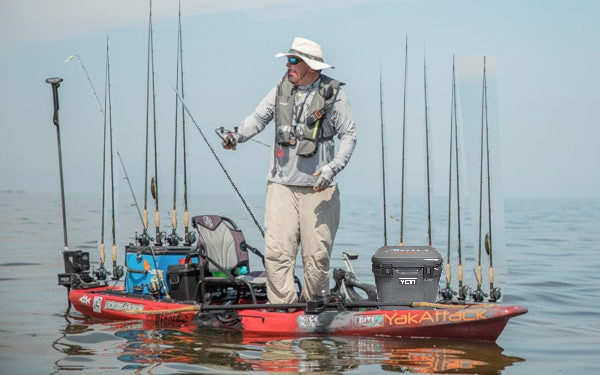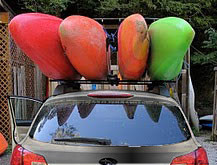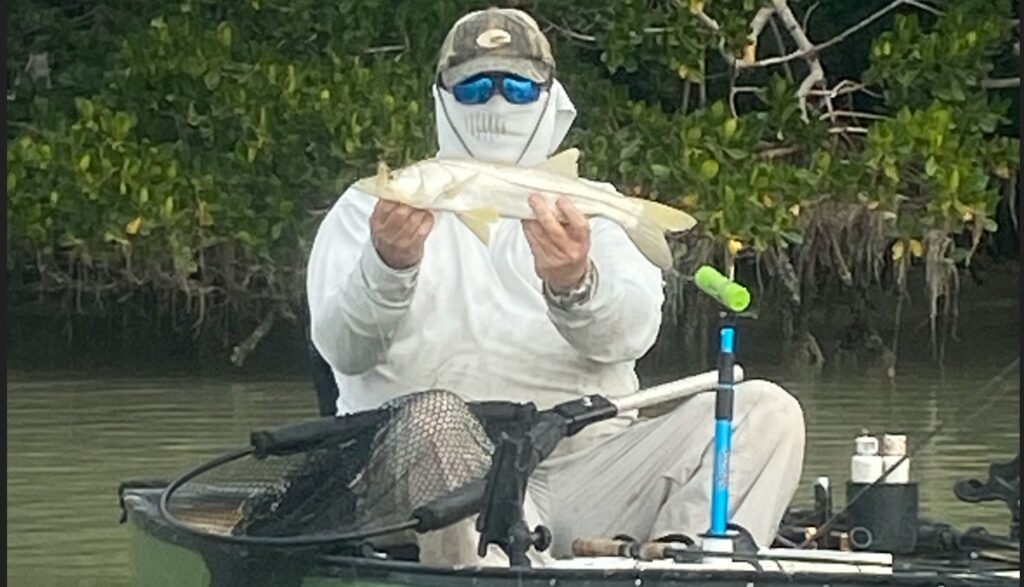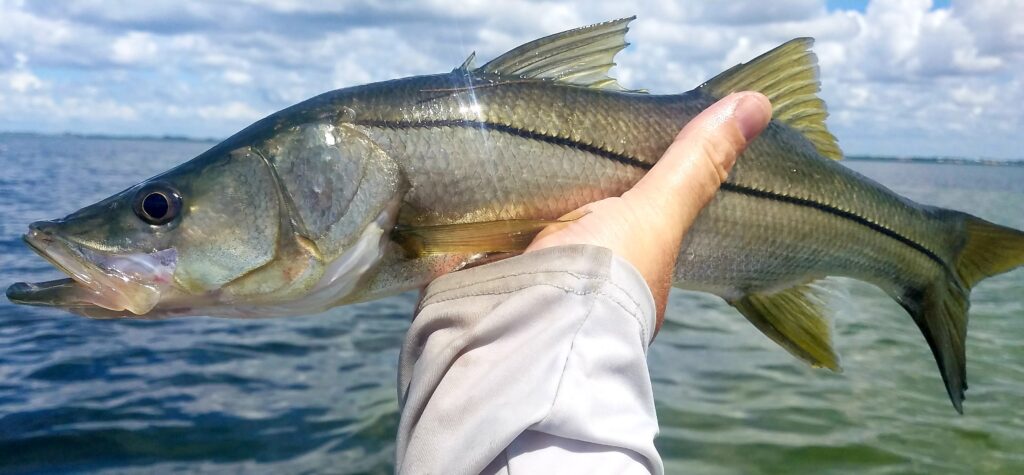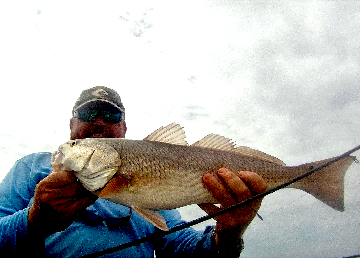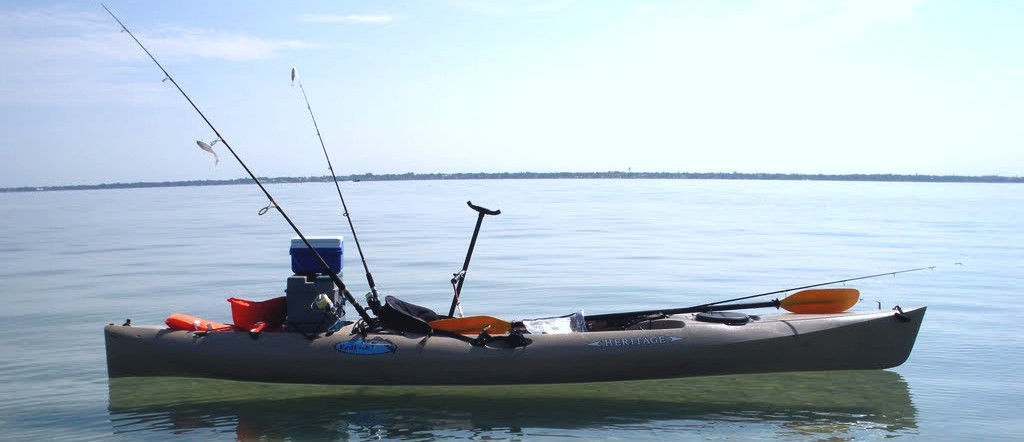
Are you having a hard time comparing fishing kayaks? Are you trying to figure out what kayak you should buy but are not sure about all the types and sizes? Do you know what specifications you should be looking for and how to eliminate kayaks that just won’t work for what you are trying to do?
In this article I try to shed some light on how to compare kayaks and what you should be looking out for when picking one that will set you up for many great days out on the water. It might be a bit long for most so if you just want to get to the must read section jump to the part on Weight Capacity. Buying a kayak with insufficient Weight Capacity is the number one mistake I see newcomers make and why they quit after a few miserable outings.
Do your Homework. Avoid Buyers Remorse
When choosing a kayak for fishing, there are several factors to consider to ensure that you choose the right one for your needs. Many times someone has told me they tried kayak fishing but didn’t like it. Nine times out of ten it was because they selected a kayak solely based on budget didn’t even think (or know) about the minimum requirements to succeed.
Often times its an impulse big box purchase for a low end $250-$300 because it was on sale or seemed like a great idea at the time and what I hear all the time is “its good enough for me”. On their first trip they strap their vessel to the roof with some pool noodles and rope, they take all their gear while dreaming of limits and personal bests.
A couple hours later… the back is sore, legs are tingling and both biceps are on fire. The entire trip they struggle to keep the kayak in a good fishing position because it’s not easy to paddle and cast at the same time when the wind is blowing ten. To top it off they can’t just relax because their inexperience makes them feel as if the are going to flip because every shift of weight the kayak is jerky and instincts take over tightening up all the core muscles because this is what keeps you upright on land. The tranquil, picturesque fishing trip turns into a stressful, unproductive day filled with nothing but pins and needles, sciatica, sore abs and buyers remorse.
This is an unfortunate story I have heard more than once, but it is easily avoidable. Below is my take on how to compare kayaks so that you can select the one that set you up to succeed.
Picking Your Kayak Type
The type of kayak you choose will depend on your preference and the conditions you plan to fish in. There are three main types of kayaks for fishing: sit-in kayaks, sit-on-top kayaks, and inflatable kayaks.
Sit-In Kayaks
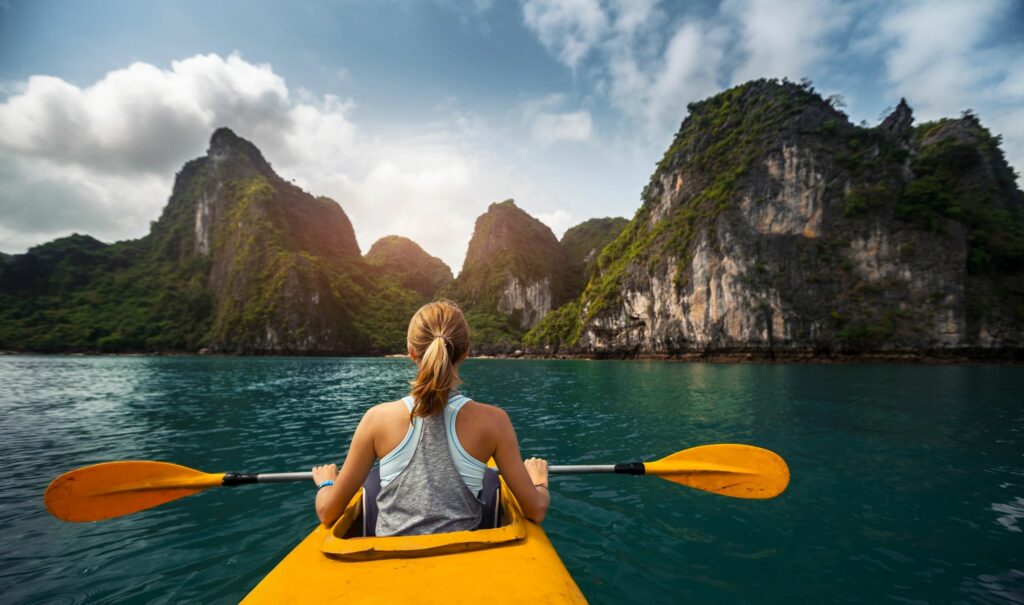
Sit-in kayaks offer more protection from the elements and provide a lower center of gravity, which makes them more stable. Sit-ins are dryer and a good solution for cold weather when used properly. They also come in very short sizes and can be much easier to transport but can be cumbersome to enter and exit.
They also can fill with water making reentry a bit more difficult and some models will even sink. But for the right angler they can be a good match.
I often run into a paddler that has a 10ft sit-in that weights 40lbs. He keeps in the back of his truck most days so when the opportunity comes he is ready to go. It takes him about two minutes to get on the water from the parking lot. He puts his paddle and rod in one hand and grabs the kayak with the other and he is off ripping lips before I even get mine unstrapped from the top of my Sequoia.
Being small framed about 5’8 and no more than 150lbs makes this an ideal solution for him. He can pop in and out of the cockpit with ease and with very little gear the kayak performs as it should. If I was to try this at 6’1″ 275lbs I would either get stuck inside or I wouldn’t even make it off the launch before flipping in three inches of water.
Sit-on-top
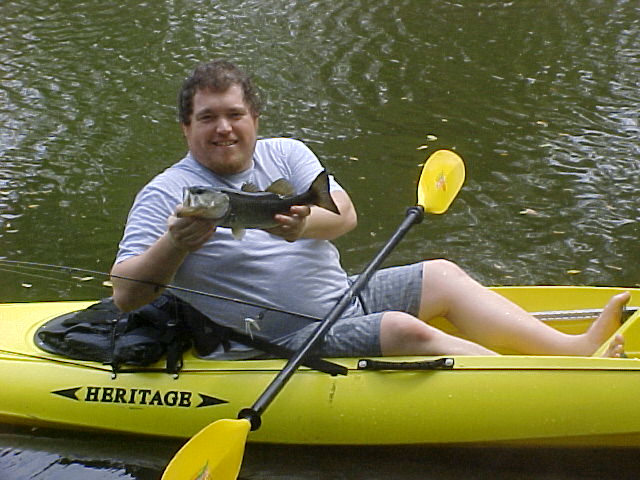
Sit-on-top kayaks are more popular for fishing because they are easy to get in and out of, and they offer more storage space for fishing gear and for the most part they are unsinkable as long as the hull is not damaged. In general a “fishing kayak” is going to be a Sit-on-top kayak with a deck design specific to fishing with molded areas for storage and mounting accessories. Some even have areas for batteries and motor mounts. They do have more plastic and can get pretty heavy making transport and storage more involved. With that, if you are serious about kayak fishing a Sit-On-Top is a great option if you can handle the physicality of getting it to and from your fishing spots.
Tip: Sit-on-top Kayaks are the go to type form most experienced anglers. There are sit-in fishing kayaks and for cold rough water the dry ride may out weigh the upside to sit-ons. But here at Yakfishin365 we are all about and HIGHLY recommend a Sit-on-Top Kayaks for kayak fishing in most water.
@yakfishin365
Inflatable kayaks
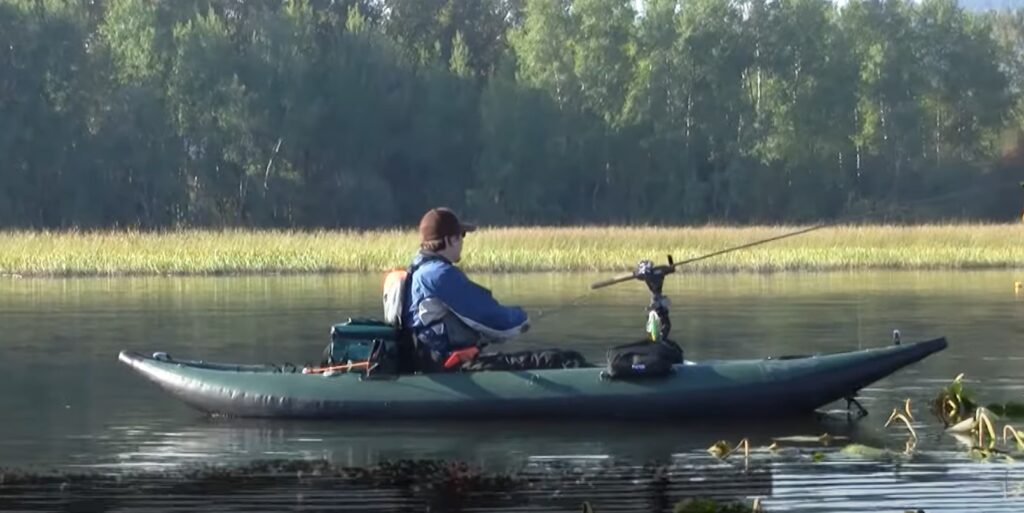
Inflatable kayaks are somewhat new to the industry and are now just getting quality level making them a lightweight and portable choice. These are a solid choice for fishing in remote locations or for those with very little storage space (condo or apartment). Many come in a storage pack with straps allowing you to carry like a backpack giving you endless possibilities when it comes to remote locations.
At some point I see getting an inflatables for my trout fishing trips where I hike into deep into public lands and federal management areas. One trip I can totally see doing is floating the Chattahoochee in Georgia. Its hundreds of miles long and runs right through Atlanta. I envision this great trip where I spend several days fishing and camping from the cold run off up in the mountains to the warmer muddy waters down in Atlanta before grabbing a several hundred dollar uber back to my put in. Of course there is a lot more to it, but this is just an example of how an inflatable can be a game changer. If you are a bit of a maverick and live in an area with remote fishing areas this could be a great solution.
Understanding Stability
Stability is a crucial factor to consider when choosing a kayak for fishing. Primary stability refers to how stable the kayak is when it’s sitting still on calm water. Secondary stability refers to how stable the kayak is when it’s tilted with the primary stability exhausted. It is very important to test paddle several kayaks whenever you can and see how they perform. You want to rock back and forth and find both their primary and secondary tipping points. If you plan on standing you are going to want a kayak with very small primary and almost non-existent secondary tipping points. These will be the wider, slower and heavy (well made) kayaks.
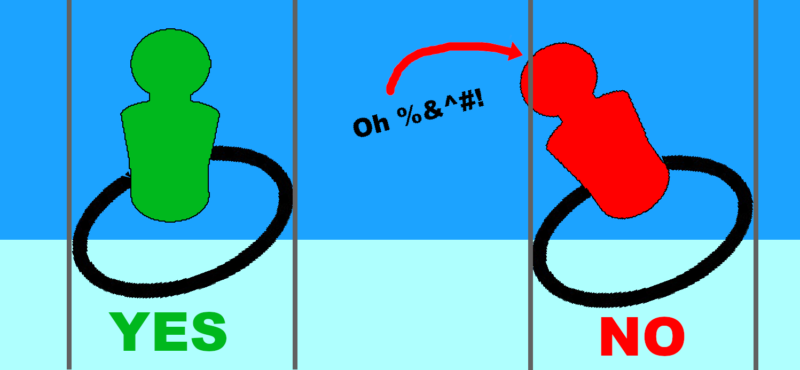
Tip: When using a kayak for the first time spend a couple minutes to get comfortable with the kayak’s primary stability. Keeping you head and shoulders perfectly vertical and in the center of the kayak, swivel your hips (think hula dancing) back and forth. At first it may feel like is going to flip but it won’t if you keep in the middle of the kayak. Flipping only occurs when your head and shoulders get too far from the center of the kayak.
Sit-on-top kayaks tend to have better primary stability because of their wider hulls. However, they can be less stable in rougher water conditions due to the majoiry of the mass sitting high off the water. Sit-in kayaks have better secondary stability because their lower center of gravity makes them less likely to tip over.
The biggest functional differences between the cheaper big box kayaks and the $1000 and up kayaks will be the stability. Wider, heavier, kayaks with highly engineered hull designs are just going to be more stable. I have owned kayaks that are 28″ to 34″ wide and 12′ to 14′ long. In general the wider my kayak the more stable it is, however its not always that case because hull design makes a major impact as well. So much so, I have a kayak thats 32″ wide and I can stand in it much easier than my wider 34″ kayak because the hull flares out on this sides creating two pontoon like shapes running down each side.
There are exceptions to the rules, so it is paramount you do everything you can to test kayaks you are thinking of buying and at the very least try to talk to someone that owns one you are looking at and get their take on the boat.
Things that impact stability
- Width of Kayak
- Hull Shape of Kayak
- Height of your seat
- How close your are to the Kayaks’ weight capacity
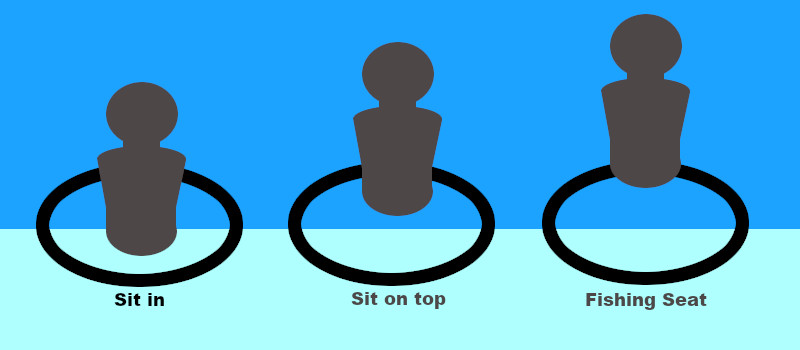
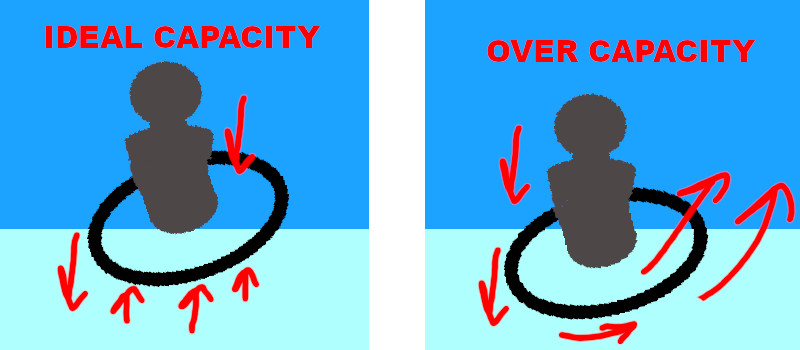
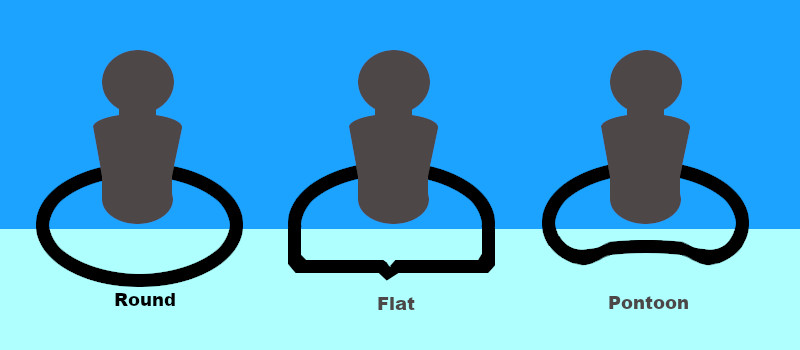
Get Comfortable with Proper Seating
There are several seating options available for kayaks, each with their own set of pros and cons that can impact performance and cost.
Basic Molded Seats
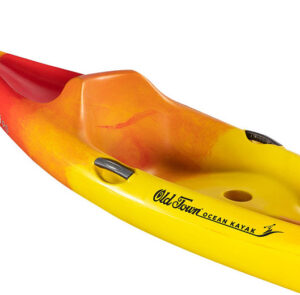
Basic molded seats are often the most affordable option and come standard with many entry-level kayaks. While these seats provide a simple and comfortable seating option, they often lack the adjustability and support that more advanced seating options offer.
Pros: Affordable, simple and comfortable.
Cons: Limited adjustability and support, can become uncomfortable during long trips.
Adjustable Molded Seats
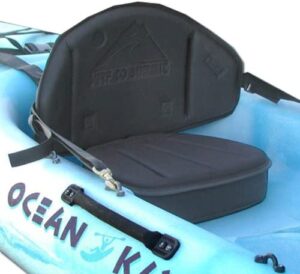
Adjustable molded seats are created with the addition of padded seat and back that fits the molded seat. The seats offer more support and adjustability than basic molded seats, and are typically found on mid-range kayaks. These seats often feature adjustable backrests, allowing anglers to customize their seating position for increased comfort and performance.
Pros: More support and adjustability, often found on mid-range kayaks.
Cons: Less support than high-end seating options, can still become uncomfortable during long trips.
High-End Seats
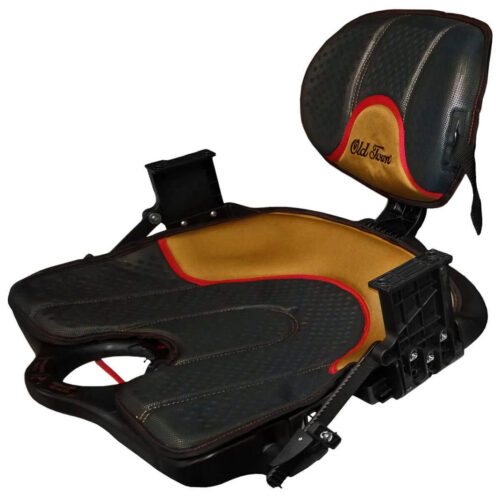
High-end seats are the most advanced seating option available, typically found on top-of-the-line kayaks. These seats often feature adjustable backrests, lumbar support, and padding for maximum comfort and performance.
Pros: Maximum adjustability, support, and comfort, ideal for long trips and experienced anglers.
Cons: Most expensive seating option, not found on entry-level kayaks.
Framed Chairs
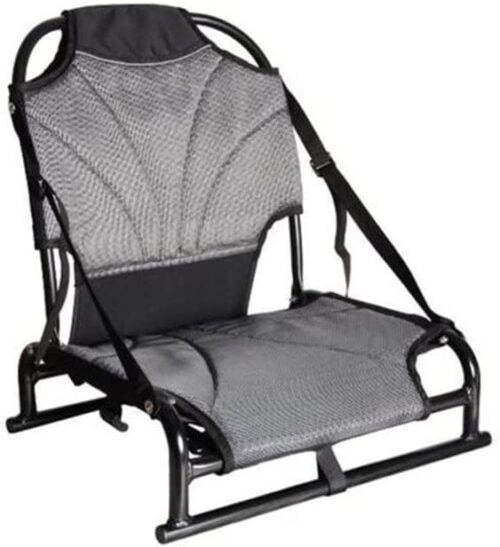
Sit-on-top fishing kayaks with adjustable framed chairs are a popular option among anglers due to their versatility and comfort. These kayaks feature a seat that is mounted on a frame, which allows for a higher level of adjustability and support than traditional molded seats. Here are some of the pros and cons of this type of seating option:
Pros:
- Comfort: The adjustable framed chair provides a high level of comfort, making it easier for anglers to stay on the water for longer periods of time.
- Support: The frame of the chair provides additional support to the angler’s back, which can help to alleviate pain and discomfort during long paddles.
- Adjustability: The ability to adjust the height, angle, and positioning of the chair allows anglers to customize their seating position for optimal comfort and performance.
- Visibility: The higher seating position of the adjustable framed chair provides better visibility, making it easier for anglers to spot fish and navigate through shallow waters.
Cons:
- Price: Sit-on-top fishing kayaks with adjustable framed chairs are typically more expensive than kayaks with basic molded seats.
- Weight: The added weight of the chair and frame can make these kayaks heavier and more difficult to transport.
- Stability: While the higher seating position can provide better visibility, it can also make the kayak less stable, especially in rough waters.
- Durability: The frame of the chair can be more prone to damage than a molded seat, requiring additional maintenance and repairs.
Overall, sit-on-top fishing kayaks with adjustable framed chairs are a great option for anglers who prioritize comfort and adjustability. While they may be more expensive and heavier than other options, the added support and customization can make a big difference in overall performance and enjoyment on the water. Additionally, if you are looking to stand having a chair makes getting up and down much easier. As with any seating option, it is important to consider personal needs and preferences when selecting the right option for your kayak.
Select the Correct Kayak Size
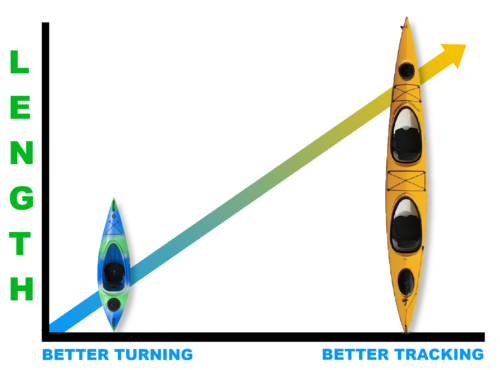
The size of a fishing kayak can have a significant impact on its performance, safety, and overall experience on the water. Generally speaking, larger kayaks tend to offer better stability and storage space, while smaller kayaks are more agile and easier to maneuver.
When it comes to performance, larger kayaks are generally more stable and can handle rough waters better than smaller ones. They are also better suited for carrying heavy loads, such as camping gear or fishing equipment. However, they can be more difficult to maneuver in tight spaces, and they may require more effort to paddle over long distances.
On the other hand, smaller kayaks are more maneuverable and easier to paddle, making them ideal for exploring narrow waterways or casting in tight spaces. They can also be easier to transport and store when not in use. However, smaller kayaks may not offer as much stability in rough waters, and they may not have as much storage space for gear.
In terms of safety, the size of a kayak can impact its stability and ability to handle different water conditions. Larger kayaks can offer more stability, but they can also be more difficult to right if they capsize. Smaller kayaks are generally easier to right, but they may not offer as much stability in rough waters.
Tip: Kayak Fishing is all about stealth and patience so don’t get to hung up on speed. The slower you go the more you see. Its more important to have a comfortable seat, stability and enough capacity for all your gear.
@yakfishin365
Ultimately, the size of a fishing kayak depends on personal preference and intended use. Larger kayaks may be better suited for anglers who plan to carry a lot of gear or fish in open water, while smaller kayaks may be ideal for those who prioritize agility and ease of transport. Regardless of size, it is important to choose a kayak that is appropriate for your skill level and experience on the water.
Understand the Manufacturing Processes and Materials
When choosing a kayak, it’s important to consider the manufacturing processes and materials used to make it. High-quality kayaks are typically made of rotomolded plastic or composite materials, which are durable and long-lasting.
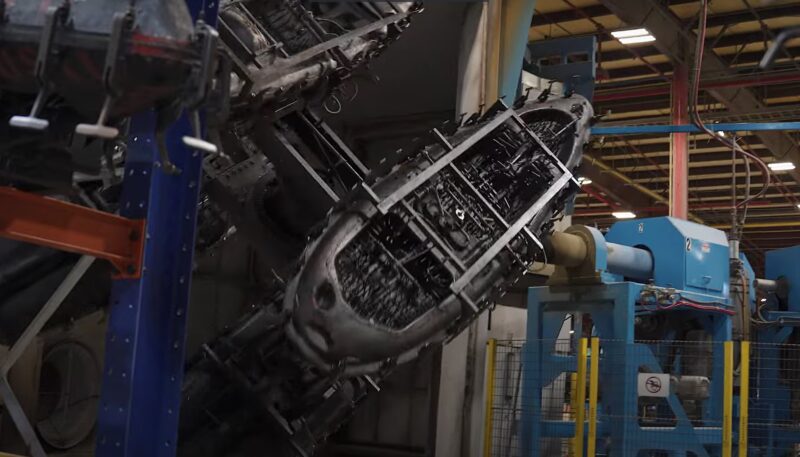
Rotomold
Rotomolded plastic kayaks are made by heating plastic pellets until they melt and then pouring the melted plastic into a mold. This process creates a seamless, one-piece kayak that is strong and durable.
Not all rotomolded kayaks are created equal, and there are significant differences between cheap and high-quality rotomolded kayaks in terms of their thickness and manufacturing process.
Cheap rotomolded kayaks are typically made with thin walls and minimal reinforcement. This makes them lightweight, but also less durable and more prone to cracking or puncturing. In contrast, high-quality rotomolded kayaks are made with thicker walls and additional layers of reinforcement, such as ribs, chines, or keels. This makes them more resistant to impact and abrasion, and better able to withstand harsh conditions.
The manufacturing process for rotomolded kayaks also plays a significant role in their quality and durability. Cheap rotomolded kayaks are often made using a faster and less precise manufacturing process, which can result in imperfections or inconsistencies in the material. This can lead to weak spots or defects that can compromise the kayak’s strength and longevity.
High-quality rotomolded kayaks, on the other hand, are made using a slower and more precise manufacturing process that ensures the material is evenly distributed and free of defects. This results in a more uniform and consistent material that is stronger and more durable overall.
While both cheap and high-quality rotomolded kayaks are made using the same basic process, there are significant differences in their thickness and manufacturing process. High-quality rotomolded kayaks are made with thicker walls and additional layers of reinforcement, as well as a more precise and consistent manufacturing process. These features make them more durable, long-lasting, and better able to withstand harsh conditions, which can be crucial for anglers who need a reliable kayak for fishing.
Thermoform
Thermoform kayaks are a relatively new addition to the kayaking market and offer a unique combination of durability and affordability. Unlike rotomolded kayaks, which are created by heating and molding plastic pellets into a specific shape, thermoform kayaks are made using a process that involves heating and vacuum-forming a sheet of ABS plastic over a mold. This results in a kayak that is lighter and more rigid than a rotomolded kayak, while still retaining the durability and strength needed for outdoor adventures.
Compared to composite kayaks, thermoform kayaks are generally less expensive and easier to repair. While composite kayaks offer unparalleled performance and aesthetics, they can also be more fragile and prone to damage. Thermoform kayaks offer a good balance of affordability, durability, and performance, making them a popular choice for recreational kayakers and anglers.
One potential downside to thermoform kayaks is that they may not offer the same level of customization as composite kayaks. While composite kayaks can be built to exact specifications, thermoform kayaks are typically produced in larger quantities and may not offer the same level of individualized adjustments. However, for those who prioritize affordability and durability over customization, thermoform kayaks can be a great option.
Overall, thermoform kayaks offer a high level of durability, affordability, and performance, making them a great choice for a wide range of outdoor enthusiasts. While they may not offer the same level of customization or performance as composite kayaks, they are a great option for those who want a high-quality kayak at a more affordable price point.
Composite
Composite kayaks are made by layering fiberglass or Kevlar over a mold and then applying resin to bond the layers together. This process creates a lightweight and strong kayak, but it’s also more expensive.
Composite kayaks are a high-end option for anglers who demand the best in terms of performance, speed, and agility. There are several quality levels of composite kayaks available on the market, and each offers unique features and benefits that set them apart from one another.
The lowest quality level of composite kayaks is often made with a single layer of fiberglass or carbon fiber. While these kayaks are relatively inexpensive, they lack the strength and durability of higher quality composite kayaks. They are more prone to cracking or puncturing and are less able to withstand rough conditions.
Mid-range composite kayaks typically feature multiple layers of fiberglass or carbon fiber, which provide increased strength and durability compared to lower quality composite kayaks. They are also often reinforced with kevlar or other high-strength materials, which further enhances their resistance to impact and abrasion. These kayaks are more expensive than lower quality composite kayaks, but they offer better performance and longevity.
The highest quality level of composite kayaks is typically made with advanced composite materials such as aerospace-grade carbon fiber or high modulus aramid fiber. These materials are stronger, lighter, and more resistant to impact and abrasion than lower quality composite materials. They are also more expensive to manufacture and purchase, making these kayaks the most expensive option on the market.
In terms of manufacturing process, higher quality composite kayaks are typically made using a more precise and time-consuming process. This involves carefully layering the composite materials and applying pressure and heat to bond them together into a strong and durable structure. Lower quality composite kayaks may use a less precise process that results in a less consistent material, which can compromise the kayak’s strength and longevity.
Composite kayaks come in different quality levels that vary in terms of materials, manufacturing process, and price. Lower quality composite kayaks may offer a lower price point, but they lack the strength and durability of higher quality composite kayaks. Mid-range composite kayaks offer a good balance of performance, durability, and affordability, while the highest quality composite kayaks provide the ultimate in performance, speed, and agility for anglers who demand the best.
When choosing a kayak for fishing, consider the type of kayak, stability, size, and material. Think about your preferences and the conditions you plan to fish in to choose the right kayak for your needs. Remember to look for well-made kayaks that are durable and long-lasting, and test the kayak for comfort and stability before making a purchase.
Appropriate Weight Capacity is a REQUIREMENT!
When selecting a fishing kayak, weight capacity is an important factor to consider. However, it is important to understand the difference between weight capacity and usable weight capacity to ensure that you choose a kayak that is safe and practical for your needs.
In general thing of weight capacity as the maximum amount of weight that a kayak can carry without sinking to the bottom.
Usable weight capacity on the other hand, refers to the amount of weight, you and your gear, that a kayak can carry while still maintaining optimal (or close to) performance, safety, and stability. The challenge, not all manufactures publish this number so you have to figure it out yourself.
There is no standard on how to calculate a kayaks’ weight limit; aka Usable Capacity. A general 70%-80% of the published capacity will give your a good idea on the boats limit. For a kayak with a 350lb capacity your usable weight is anywhere from 245lbs to 280lbs. To make thing even easier I use a 100lb Rule. Take your kayak’s capacity (350lbs) and subtract 100lbs (250lbs). This will always put you in a boat that will perform as expected. Additionally, if you come across anything unplanned on the water you have the extra capacity to deal with it safely. This includes bringing home a cooler you find floating out in the middle of no where, recuing an exhausted dog swimming a mile offshore, or even saving tourist caught in the rip current. (I have done all these).
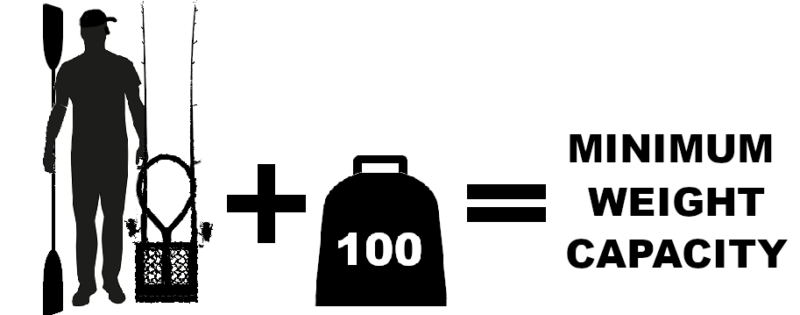
Choosing a kayak with a weight capacity that is too low can be dangerous. Fishing a kayak that is too small will not only submerge past the the hull design that keeps it stable, the kayak’s buoyancy (water pushing the kayak up) really starts to build up energy that just wants to pop the kayak up on the surface they way its designed. This makes for a very unstable situation. If you have ever tried to push a beach ball underwater with one hand you will find the ball fighting to twist, roll and pop out from under your grip. The same thing happens to an overly submerged kayak. The slightest weight shift (hook set, reaching for tackle, lipping a fat sally) can cause the kayak to squirt out from under you flipping you so fast you are in the water before you can react (ask me how I know).
Other things to consider about weight capacity
It is also important to note that weight capacity and usable weight capacity can vary depending on the type of kayak. For example, sit-on-top kayaks may have a higher weight capacity than sit-inside kayaks due to their design, but may also have a higher center of gravity and be less stable in rough waters. Additionally, inflatable kayaks may have a lower weight capacity than rigid kayaks, but may be more lightweight and easier to transport.
You also need to factor into where and how you fish. Personally, I am in 2-3ft of 80 degree water 90% of the time I am fishing here in Florida. So flipping my kayak usually just means a yard sale and a few lost items with a very low safety risk. Drowning and Hypothermia are still technically in play but nothing like fishing for halibut off the rocky shored North West where the dark blue waters off the coast are cold, deep, rough year round. Flipping out there is an automatic life threatening situation.
You also need to consider how and what you car fishing for. Catching a 30lb fish 100ft off the bow in 3ft of water is a much different experience catching one straight down in a 100ft of water. Fish can make surprisingly quick and very strong runs, spinning, twisting and turning your kayak very aggressively. Depending if this force is vertical (fishing straight down) or horizontal (fishing shallow with long casts) the stability of the same kayak can be different.
When I plan my day I need to decide the amount of gear I am taking and this is all based on how much usable capacity my kayak has and where I am going fishing. If I am in deep, more dangerous waters I take the bare minimum for two reasons. One, if I flip I will lose less gear. Two, I want the kayak to be as stable as possible giving me the best chance at staying upright. If I am fishing the flats, where I can just stand if I flip, I may press my luck and eat into that 100lb buffer and bring some extra gear.
Kayak Weight will Make or Break You
How much your kayak weighs is also a big factor when comparing Kayaks. Here are some things to consider:
How am I going to transport my kayak? Trailer, Truck Bed, Car Top, SUV top?
Big heavy peddle and motor kayaks work well on a trailer but many kayak launches are small and parking with trailers can be difficult and in some places not allowed. Truck beds are quick and convenient but not nearly long enough to support longer kayaks properly especially during a long hot summer road trip. Transporting your kayak on a roof top also has its pros and cons. Obviously large heavy kayaks are going to be harder to load and even more difficult on a full-sized SUV that’s about 2 feet higher. On the plus size every vehicle can transport a kayak and there are many aftermarket products to make it easy and safe.
Tip: Car topping a heavy kayak can be done one end at a time so you only need the strength to lift half your kayak.
@yakfishin365
My rule of thumb is you have to be able to lift half (well maybe a little more than half) of you kayak’s weight over your head and be able to lift the total weight of they kayak off the ground. This will allow you to load and unload you kayak on anything anytime by yourself.
Suggested Reading: How to Car Top your Kayak
How far is my portage to the water? Can I get my vehicle close to the shoreline? Can I carry my kayak alone?
Most of my launches I can get just feet from the waters edge so a 10-20ft carry is all I need most of the time. Where I need more of portage I have a two wheeled kayak cart that allows me to roll my loaded kayak to the water. Big heavy kayaks will most always require a cart even for those 20ft portages. Doesn’t seem like a big deal at first but getting you kayak on and off a cart isn’t the most graceful task and after 12hr/20mi paddle it can make a simple task exhausting. Not to mention the 5-10mins it adds to loading and unloading which translates to less fishing.
Conclusion
Overall, when selecting a fishing kayak, it is important to consider both weight capacity and usable weight capacity. Understanding the difference between these two factors and how they can impact the performance and safety of your kayak will help you choose the ideal kayak for your needs and ensure a safe and enjoyable fishing experience. At the very least you want to have 100lbs of FREE Capacity. This will give you your best chance at maximizing the kayak’s design and your paddling experience. You also have to take into concertation how and where you will use your kayak, what type of fishing you will be doing and lastly how you will be transporting to and from the launch.

